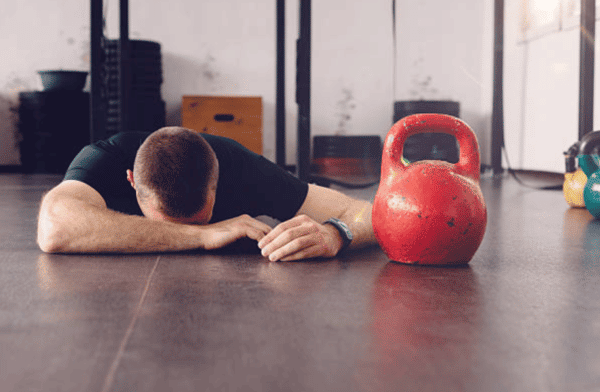Les épaules sont des articulations à la fois fragiles et complexes. Située au niveau de l’épaule, la coiffe des rotateurs illustre parfaitement ce constat. Pour préserver l’articulation de l’épaule et rester en bonne santé durablement, cet ensemble de muscles doit être renforcé au quotidien.
Malheureusement, la coiffe des rotateurs est trop souvent négligée par les pratiquants de musculation. Dans cet article, découvrez comment en prendre soin pour éviter les blessures.
La coiffe des rotateurs, en bref :
- Elle est composée de 4 muscles stabilisant l’articulation de l’épaule.
- Elle est essentielle pour les mouvements du quotidien et les sports sollicitant les bras.
- Une coiffe des rotateurs faible augmente le risque de blessures telles que les tendinites ou les déchirures.
- Un bon échauffement et un renforcement musculaire régulier préviennent les blessures.
- Les exercices à l’élastique et avec haltères renforcent les muscles rotateurs externes.
Sommaire
Qu’est-ce que la coiffe des rotateurs ?
Anatomie de la coiffe des rotateurs
La coiffe des rotateurs est une partie de l’épaule composée de 4 muscles :
- Le muscle sous-épineux (ou infra-épineux)
- Le muscle sus-épineux (ou supra-épineux)
- Le subscapulaire (ou sous-scapulaire)
- Le muscle petit rond
Ces différents muscles partent de l’omoplate et se terminent sur l’humérus.
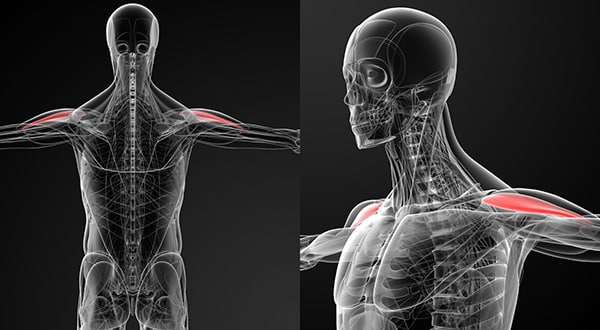
Parmi ces 4 muscles de l’épaule, un seul est visible de l’extérieur : le sous-épineux. Les 3 autres sont des muscles profonds qui n’ont aucune incidence sur l’esthétique de votre physique. En effet, ils sont cachés sous le muscle deltoïde.
Mais ce n’est pas une raison pour les négliger. Bien au contraire !
Quel est son rôle ?
Vous n’en avez certainement pas conscience, mais nous utilisons nos épaules dans la plupart des gestes du quotidien.
Que ce soit pour enfiler un t-shirt, faire le ménage ou se laver les cheveux, elles sont extrêmement sollicitées.
Cela est encore plus flagrant chez les sportifs. La pratique d’une activité physique telle que la musculation, le basket-ball, le handball, le tennis, le rugby, ou tout autre sport qui nécessite de lever les bras, implique mécaniquement la mobilité de l’épaule.
Justement, le rôle de la coiffe des rotateurs est de stabiliser l’articulation de l’épaule, de manière à éviter les blessures. C’est grâce à ces tendons que vous pouvez bougez vos bras dans toutes les directions sans souffrir de douleurs à l’épaule.
Plus précisément, le sous-épineux et le petit rond sont des rotateurs externes. Ils favorisent les mouvements de bras vers l’extérieur. À l’inverse, le muscle subscapulaire permet la rotation interne. Le supra-épineux intervient quant à lui lors des mouvements d’abduction du bras (lorsque les bras s’écartent du corps).
Maintenant que vous savez à quoi sert la coiffe des rotateurs, vous comprenez certainement son importance pour la pratique de la musculation. Cet ensemble de muscles intervient dans la plupart des exercices de votre programme d’entraînement. Mais il s’agit malheureusement d’une partie du corps fragile dont il convient de prendre soin.
Des tendons fragiles
Les blessures aux épaules sont très courantes chez les athlètes. Plusieurs raisons peuvent l’expliquer.
De par son extrême mobilité, cette articulation est naturellement sujette à des dysfonctionnements.
Comme nous l’avons vu, les sports qui entraînent des gestes répétés des bras peuvent causer des traumatismes.
Mais c’est aussi le cas de certains métiers (peintres, employés d’usines à la chaîne, ouvriers en bâtiment, etc.), dont les mouvements répétitifs ont tendance à abîmer les tendons.
Ce phénomène s’accentue avec l’âge. Plus le temps passe, plus la coiffe des rotateurs observe une perte de force et d’élasticité. Les douleurs de la coiffe des rotateurs sont alors plus fréquentes et plus intenses.
La tendinopathie de la coiffe des rotateurs et la déchirure sont les 2 blessures les plus courantes.
La tendinite de la coiffe des rotateurs se produit lorsque les tendons subissent une inflammation. Elle peut être extrêmement douloureuse et véritablement handicapante au quotidien, vous empêchant de vaquer à vos occupations favorites.
Plus grave encore, les lésions de la coiffe peuvent être le résultat d’une tendinite mal soignée. Il peut s’agir d’une déchirure partielle ou d’une rupture complète.
Cette blessure peut également être liée à un traumatisme. Une mauvaise chute lors d’un match de basket-ball, un contact trop violent lors d’une rencontre de rugby ou un accident de voiture peuvent, par exemple, être à l’origine d’une telle blessure.
Les symptômes d’une rupture de la coiffe des rotateurs sont de vives douleurs à l’épaule (au toucher et lors des mouvements) et une impression de faiblesse.
Dans tous les cas, consultez un professionnel de santé. Ce dernier vous préconisera certainement de passer une IRM (imagerie par résonance magnétique) pour s’assurer du diagnostic et décider de la suite à donner.
Comment soigner la coiffe des rotateurs ?
Pour soigner une tendinite à l’épaule, vous devrez vous armer de patience et observer du repos pendant plusieurs semaines. Le but est simplement de calmer l’inflammation.
Après avis d’un médecin, vous pourrez éventuellement prendre des anti-inflammatoires.
Des séances avec un kinésithérapeute sont aussi conseillées pour accélérer la guérison.
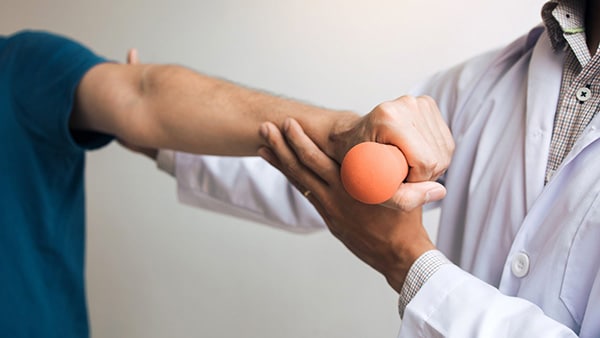
Dans certains cas, si les douleurs perdurent, une hospitalisation avec une intervention chirurgicale peut être nécessaire.
En cas de rupture, une opération de la coiffe des rotateurs est bien souvent indispensable. À l’issue de la chirurgie de l’épaule, vous suivrez un protocole de rééducation avec un kiné pour renforcer et assouplir vos muscles.
Comment en prendre soin pour prévenir les blessures ?
Très souvent, une épaule douloureuse est le signe d’une coiffe des rotateurs trop faible. Cela vaut aussi bien pour les sportifs que pour les personnes sédentaires.

Avant de vouloir soulever des charges lourdes à la salle de sport, il est donc fondamental de faire un renforcement de la coiffe des rotateurs.

DÉCOUVREZ TOUS MES PROGRAMMES
Il est tout aussi essentiel de bien vous échauffer avant vos entraînements de musculation. Effectués avec des charges faibles, ces exercices peuvent tout à fait être intégrés à votre échauffement. Il est d’ailleurs inutile d’utiliser des poids lourds pour travailler votre coiffe des rotateurs.
Compte tenu de leur rôle capital, ces exercices visent à développer en priorité le muscle sous-épineux et le petit rond. Le muscle sus-épineux doit aussi être sollicité pour la stabilisation générale de l’épaule.
En revanche, le sous-scapulaire ne doit pas être renforcé, car il favorise la bascule des épaules vers l’avant.
Exercice 1 : le travail à l’élastique
Pour ce premier exercice de la coiffe des rotateurs, ce sont les muscles petit rond et infra-épineux qui sont sollicités.
Vous devrez simplement vous munir d’une bande élastique de résistance faible ou moyenne. Tenez une extrémité de l’élastique dans chacune de vos mains. Ces dernières doivent être devant vous, écartées de la largeur des épaules.
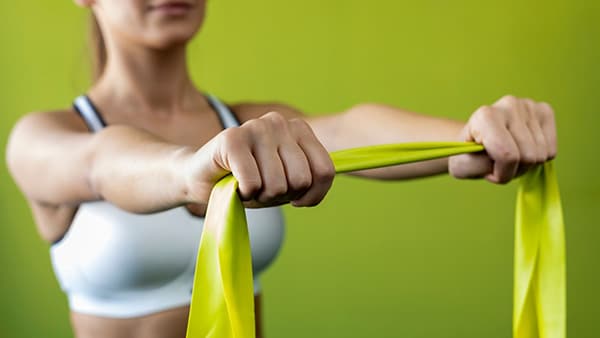
Tout en maintenant vos coudes le long du corps, l’exercice consiste à écarter vos mains vers les côtés, à tenir la position quelques secondes puis à revenir en position de départ en contrôlant le geste.
Ce mouvement alterne donc entre une phase concentrique et une phase excentrique.
Effectuez 3 séries de 10 à 15 répétitions, idéalement 2 ou 3 fois par semaine.
Exercice 2 : les rotations internes et externes
Cet exercice se concentre uniquement sur la contraction excentrique. Il aide à renforcer les muscles dont le rôle est d’assurer la rotation externe de l’épaule, à savoir le sous-épineux et le petit rond.
Pour l’exécuter, fixez un élastique de résistance à une poignée de porte ou de fenêtre (ou à tout autre objet suffisamment solide pour ne pas se dérober durant l’exercice). Vous pouvez aussi utiliser une poulie à la salle de musculation.
Si vous n’avez pas de solution pour accrocher l’élastique, maintenez-le avec votre main inutilisée.
Placez-vous de profil par rapport à la porte. Saisissez l’élastique avec :
- La main la plus proche de la porte pour travailler la rotation interne (fermeture)
- La main la plus éloignée de la porte pour travailler la rotation externe (ouverture)
L’exercice consiste à plier votre coude à 90 degrés, puis à tirer la bande de résistance dans la direction opposée à la porte. Imaginez que vous cherchiez à tendre l’élastique. En fonction du degré de résistance du matériel et de votre niveau physique, vous pouvez vous rapprocher de la porte pour faciliter le mouvement, ou au contraire vous en éloigner.
Veillez à bien effectuer les 2 rotations avec chaque bras. Comme pour l’exercice précédent, 3 séries de 10 à 15 répétitions vous permettront de renforcer votre coiffe des rotateurs.
Exercice 3 : le L-Fly avec haltère
Toujours pour renforcer les rotateurs externes (infra-épineux et petit rond), le L-Fly se pratique avec un haltère.
Sur un banc de musculation ou sur le sol, allongez-vous de côté. Vos jambes sont l’une sur l’autre. Saisissez un haltère avec votre bras le plus en hauteur. Gardez ce bras le long du corps, le coude plié à 90 degrés.
Par un mouvement de rotation externe, votre objectif est de remonter l’haltère le plus haut possible, avant de revenir en position initiale.
Répétez ce mouvement 10 à 15 fois sur 3 séries.
Exercice 4 : les élévations latérales
Le mouvement de l’élévation latérale est idéal pour travailler le muscle sus-épineux, dans la mesure où il participe au mouvement d’abduction. Cet exercice ne permet pas d’isoler directement ce muscle profond, mais simplement de le solliciter parmi d’autres muscles de l’épaule.
Les élévations latérales peuvent être réalisées avec des haltères ou avec un élastique. Là encore, l’objectif n’est pas de travailler avec les charges les plus lourdes possibles, mais plutôt de vous concentrer sur la qualité du mouvement.
Exercice 5 : les étirements des épaules
En plus du renforcement musculaire de votre coiffe des rotateurs, il est tout aussi important de bien étirer vos épaules pour les garder en bonne santé. Au même titre que les exercices de renforcement, ceux de mobilité articulaire sont à réaliser plusieurs fois par semaine, en prévention des blessures.
Pour le premier exercice, passez simplement un bras devant vous, au-dessus de votre épaule opposée. Avec l’autre bras, appuyez sur votre coude et poussez-le légèrement vers vous.
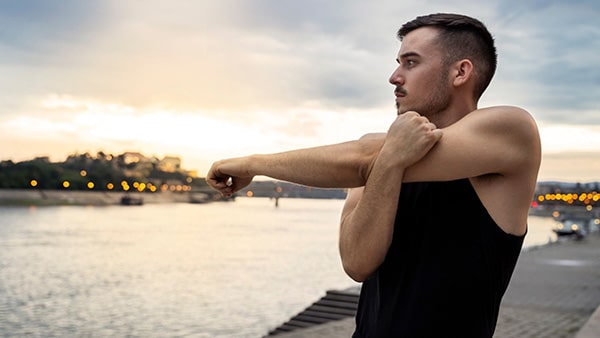
Le deuxième exercice vise à étirer le faisceau moyen. Passez votre bras derrière votre dos et agrippez votre poignet avec votre autre main. Tirez légèrement votre bras vers le bas pour ressentir un étirement de l’épaule.
Pour le troisième et dernier exercice, vous aurez besoin d’un élastique de fitness. Saisissez une extrémité dans chacune de vos mains et tendez la bande en hauteur, derrière votre tête. Maintenez la position pour sentir vos épaules s’étirer et se relâcher.
Vous avez également la possibilité d’utiliser un cadre de porte pour faire cet étirement.
Conclusion
Vous savez maintenant pourquoi vous devez absolument prendre soin de votre coiffe des rotateurs. Vos épaules sont des articulations fragiles, et les blessures nombreuses chez les sportifs.
En intégrant simplement quelques exercices de renforcement et d’étirement dans votre programme d’entraînement, vous limiterez grandement le risque de tendinite ou de déchirure. Pensez aussi à bien vous échauffer avant chaque séance de musculation.
FAQ
La coiffe des rotateurs est un ensemble de quatre muscles situés dans l’épaule. Elle stabilise l’articulation et permet les mouvements du bras.
Un renforcement régulier prévient les blessures, améliore la stabilité de l’épaule et optimise les performances sportives.
Un bon échauffement, des exercices de renforcement et des étirements réguliers réduisent le risque de blessure.
Les rotations internes et externes à l’élastique, le L-Fly avec haltère et les élévations latérales sont recommandés.
Deux à trois séances par semaine suffisent, avec des charges légères et un focus sur la technique.



